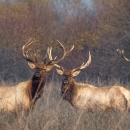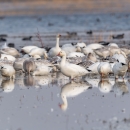About Us
Grasslands Wildlife Management Area (WMA) was established in 1979 and is located in western Merced County, California within the San Joaquin River basin. Unlike typical national wildlife refuges, Grasslands WMA is comprised mostly of privately-owned lands on which perpetual conservation easements for the benefit of wildlife have been established between landowners and the U.S. Fish and Wildlife Service. These easements preserve wetland and grassland habitats for wildlife, as well as some wildlife-friendly agricultural lands. The preservation of these areas prevents conversion of the land to uses not compatible with migratory bird and other wildlife values, while allowing daily management to remain under landowner control.
The Grasslands WMA can be divided into eastern and western divisions separated by the San Joaquin River. In the heart of the western division is the Grassland Resource Conservation District, an area of 70,000 acres of private wetlands and associated grasslands, and over 30,000 acres of federal national wildlife refuges and state wildlife areas. These wetlands constitute 30% of the remaining wetlands in California's Central Valley and are extremely important to Pacific Flyway waterfowl populations. These lands are used by over 1.5 million wintering ducks and geese and more than 300,000 shorebirds and other waterbirds.
Grasslands WMA supports diverse habitats including seasonally flooded marshlands, semi permanent marshes, riparian riparian
Definition of riparian habitat or riparian areas.
Learn more about riparian habitats, wet meadows, vernal pools, native uplands, pastures, and native grasslands. In addition to waterfowl, these habitats support shorebirds, wading birds, songbirds, raptors, and other wildlife species. Several federal and state-listed endangered and threatened plants and animals are present in the area and benefit by the habitat protection provided by the easement program. From 1979 to the present, more than 90,000 acres have been incorporated into the Grasslands WMA conservation easement conservation easement
A conservation easement is a voluntary legal agreement between a landowner and a government agency or qualified conservation organization that restricts the type and amount of development that may take place on a property in the future. Conservation easements aim to protect habitat for birds, fish and other wildlife by limiting residential, industrial or commercial development. Contracts may prohibit alteration of the natural topography, conversion of native grassland to cropland, drainage of wetland and establishment of game farms. Easement land remains in private ownership.
Learn more about conservation easement program.
The Grasslands WMA consists of 94,576 acres of perpetual conservation easements on private lands. Of this total acreage, 11,150.6 acres of Service-owned fee-title land are managed as part of the San Luis NWR, and 4,497.7 acres are managed as part of the Merced NWR. The Grasslands WMA is the largest concentrated easement program for wildlife in the State of California. Information about the Service-owned fee-title refuge units (shown on the map) can be found on the San Luis NWR website (for West Bear Creek, East Bear Creek, Blue Goose units) and the Merced NWR website (for Arena Plains, Snobird units). For public visitation opportunities, please explore the San Luis NWR, Merced NWR, and San Joaquin River NWR.
Our Mission
The mission of the National Wildlife Refuge System is to administer a national network of lands and waters for the conservation, management and, where appropriate, restoration of the fish, wildlife and plant resources and their habitats within the United States for the benefit of present and future generations of Americans.
Every national wildlife refuge national wildlife refuge
A national wildlife refuge is typically a contiguous area of land and water managed by the U.S. Fish and Wildlife Service for the conservation and, where appropriate, restoration of fish, wildlife and plant resources and their habitats for the benefit of present and future generations of Americans.
Learn more about national wildlife refuge was created for a special purpose. Some were created to protect migratory birds, others to protect threatened or endangered species or unique habitats, while others fulfill another special purpose. All activities allowed on refuges must be evaluated to make sure each activity will not conflict with the reason the refuge was founded.
The Grasslands WMA was established in 1979 under the Migratory Bird Conservation Act, Endangered Species Act, and Emergency Wetlands Resources Act. Grasslands WMA is comprised primarily of privately-owned lands on which perpetual conservation easements for the benefit of wildlife have been established between landowners and the U.S. Fish and Wildlife Service. These easements preserve wetland and grassland habitats for wildlife, as well as some wildlife-friendly agricultural lands. The preservation of these areas prevents conversion of the land to uses not compatible with migratory bird and other wildlife values, while allowing daily management to remain under landowner control.
Other Facilities in this Complex
Grasslands WMA is part of the San Luis NWR Complex. A national wildlife refuge national wildlife refuge
A national wildlife refuge is typically a contiguous area of land and water managed by the U.S. Fish and Wildlife Service for the conservation and, where appropriate, restoration of fish, wildlife and plant resources and their habitats for the benefit of present and future generations of Americans.
Learn more about national wildlife refuge complex is an administrative grouping of two or more refuges, wildlife management areas or other refuge conservation areas that are primarily managed from a central office location. Refuges are grouped into a complex structure structure
Something temporarily or permanently constructed, built, or placed; and constructed of natural or manufactured parts including, but not limited to, a building, shed, cabin, porch, bridge, walkway, stair steps, sign, landing, platform, dock, rack, fence, telecommunication device, antennae, fish cleaning table, satellite dish/mount, or well head.
Learn more about structure because they occur in a similar ecological region, such as a watershed or specific habitat type, and have a related purpose and management needs. Typically, a project leader or complex manager oversees the general management of all refuges within the complex and refuge managers are responsible for operations at specific refuges. Supporting staff, composed of administrative, law enforcement, refuge manager, biological, fire, visitor services, and maintenance professionals, are centrally located and support all refuges within the complex.
Other units in the San Luis NWR Complex include the San Luis NWR, Merced NWR, and San Joaquin River NWR.




